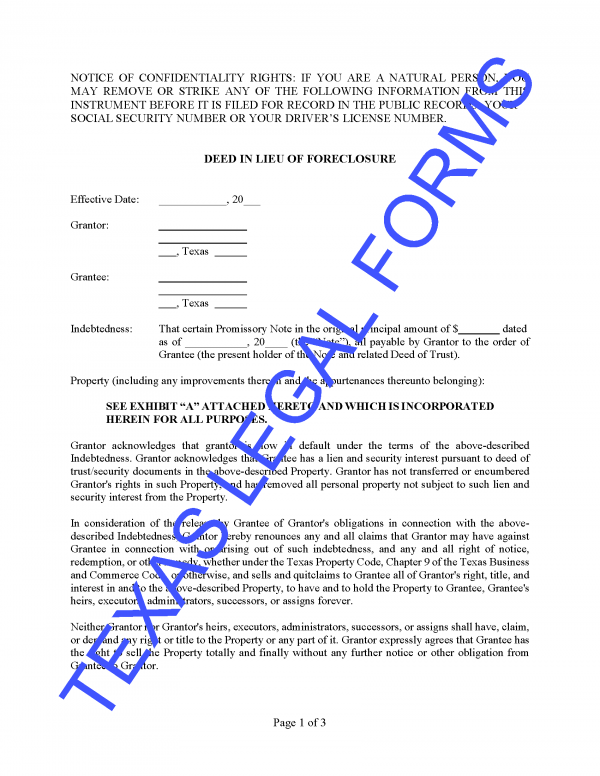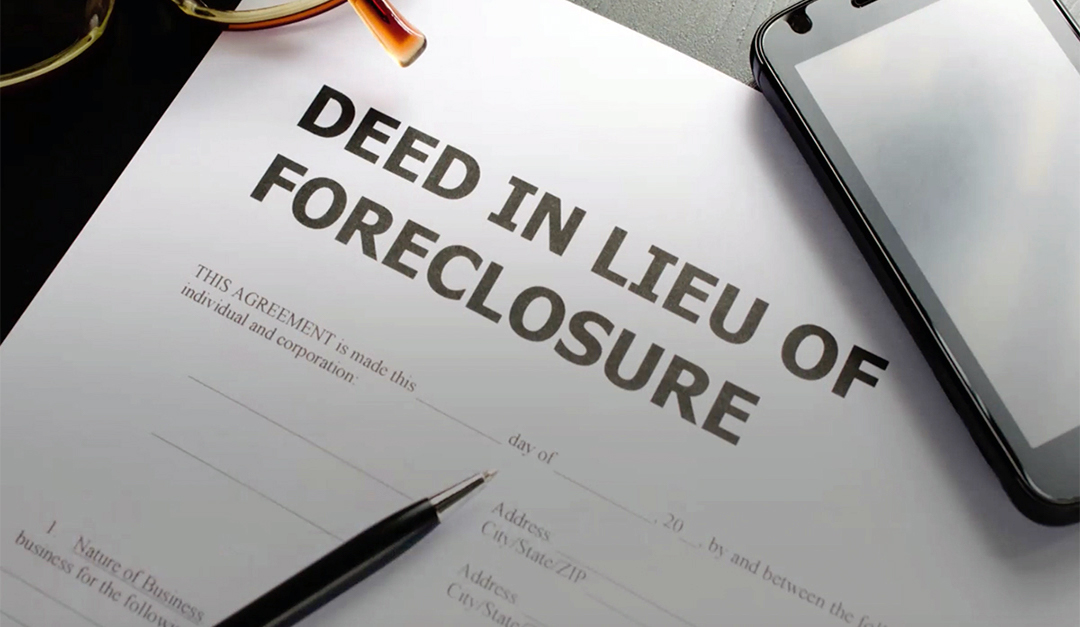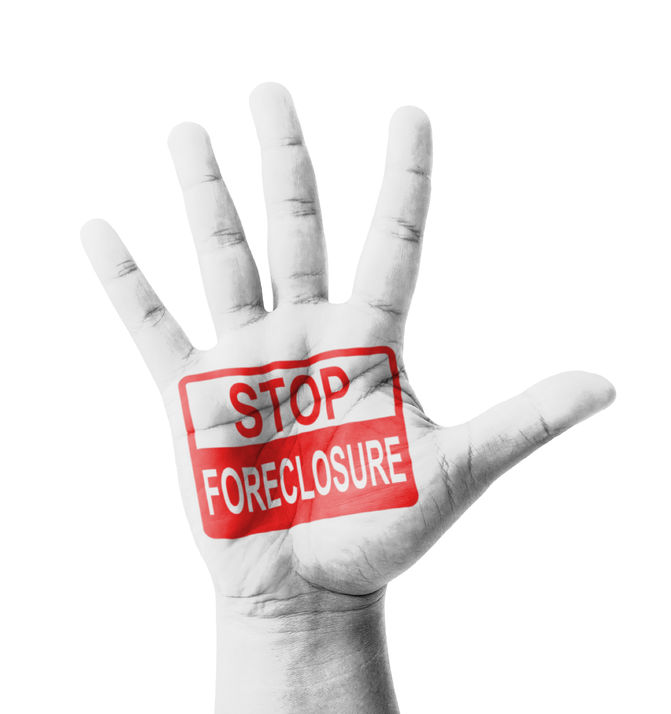A Deed In Lieu Of Foreclosure Is Also Known As
A Deed In Lieu Of Foreclosure Is Also Known As - A deed in lieu of foreclosure — also called a “mortgage release” — allows you to avoid the foreclosure process by releasing you from your mortgage payment obligation. To avoid the actual foreclosure process, the homeowner may opt to use a deed in lieu of foreclosure, also known as a mortgage release. The lender) to satisfy a loan that is in default. A deed in lieu of foreclosure may also be called a deed in lieu, mortgage release, surrender of possession agreement, voluntary liquidation, or voluntary conveyance. A deed in lieu of foreclosure is a document that transfers the title of a property from the property owner to their lender in exchange for relief from the mortgage debt. A deed in lieu of foreclosure is a deed instrument in which a mortgagor (i.e. The borrower) conveys all interest in a real property to the mortgagee (i.e. In simplest terms, a deed in lieu of.
In simplest terms, a deed in lieu of. A deed in lieu of foreclosure may also be called a deed in lieu, mortgage release, surrender of possession agreement, voluntary liquidation, or voluntary conveyance. To avoid the actual foreclosure process, the homeowner may opt to use a deed in lieu of foreclosure, also known as a mortgage release. A deed in lieu of foreclosure is a deed instrument in which a mortgagor (i.e. The borrower) conveys all interest in a real property to the mortgagee (i.e. A deed in lieu of foreclosure is a document that transfers the title of a property from the property owner to their lender in exchange for relief from the mortgage debt. The lender) to satisfy a loan that is in default. A deed in lieu of foreclosure — also called a “mortgage release” — allows you to avoid the foreclosure process by releasing you from your mortgage payment obligation.
A deed in lieu of foreclosure is a deed instrument in which a mortgagor (i.e. In simplest terms, a deed in lieu of. The lender) to satisfy a loan that is in default. A deed in lieu of foreclosure may also be called a deed in lieu, mortgage release, surrender of possession agreement, voluntary liquidation, or voluntary conveyance. The borrower) conveys all interest in a real property to the mortgagee (i.e. A deed in lieu of foreclosure is a document that transfers the title of a property from the property owner to their lender in exchange for relief from the mortgage debt. To avoid the actual foreclosure process, the homeowner may opt to use a deed in lieu of foreclosure, also known as a mortgage release. A deed in lieu of foreclosure — also called a “mortgage release” — allows you to avoid the foreclosure process by releasing you from your mortgage payment obligation.
Free Deed in Lieu of Foreclosure Form [PDF Template]
The borrower) conveys all interest in a real property to the mortgagee (i.e. The lender) to satisfy a loan that is in default. A deed in lieu of foreclosure — also called a “mortgage release” — allows you to avoid the foreclosure process by releasing you from your mortgage payment obligation. To avoid the actual foreclosure process, the homeowner may.
Deed in Lieu of Foreclosure Legal Templates
In simplest terms, a deed in lieu of. The borrower) conveys all interest in a real property to the mortgagee (i.e. A deed in lieu of foreclosure may also be called a deed in lieu, mortgage release, surrender of possession agreement, voluntary liquidation, or voluntary conveyance. The lender) to satisfy a loan that is in default. A deed in lieu.
Deed In Lieu Of Foreclosure Fill Online, Printable, Fillable, Blank
The borrower) conveys all interest in a real property to the mortgagee (i.e. To avoid the actual foreclosure process, the homeowner may opt to use a deed in lieu of foreclosure, also known as a mortgage release. A deed in lieu of foreclosure — also called a “mortgage release” — allows you to avoid the foreclosure process by releasing you.
Deed in Lieu of Foreclosure Startup Templates
A deed in lieu of foreclosure is a document that transfers the title of a property from the property owner to their lender in exchange for relief from the mortgage debt. The borrower) conveys all interest in a real property to the mortgagee (i.e. A deed in lieu of foreclosure is a deed instrument in which a mortgagor (i.e. A.
Texas Deed In Lieu Of Foreclosure Form Buy Real Estate Legal Forms
To avoid the actual foreclosure process, the homeowner may opt to use a deed in lieu of foreclosure, also known as a mortgage release. The borrower) conveys all interest in a real property to the mortgagee (i.e. A deed in lieu of foreclosure — also called a “mortgage release” — allows you to avoid the foreclosure process by releasing you.
DeedinLieu of Foreclosure Think Realty
In simplest terms, a deed in lieu of. The lender) to satisfy a loan that is in default. To avoid the actual foreclosure process, the homeowner may opt to use a deed in lieu of foreclosure, also known as a mortgage release. A deed in lieu of foreclosure is a document that transfers the title of a property from the.
A Deed in Lieu of Foreclosure Cashflow Chick
In simplest terms, a deed in lieu of. A deed in lieu of foreclosure is a deed instrument in which a mortgagor (i.e. A deed in lieu of foreclosure may also be called a deed in lieu, mortgage release, surrender of possession agreement, voluntary liquidation, or voluntary conveyance. A deed in lieu of foreclosure is a document that transfers the.
What Is a Deed in Lieu of Foreclosure? — RISMedia
The lender) to satisfy a loan that is in default. In simplest terms, a deed in lieu of. A deed in lieu of foreclosure — also called a “mortgage release” — allows you to avoid the foreclosure process by releasing you from your mortgage payment obligation. A deed in lieu of foreclosure may also be called a deed in lieu,.
Deed in Lieu of Foreclosure Missouri Real Estate Lawyer
A deed in lieu of foreclosure is a deed instrument in which a mortgagor (i.e. The lender) to satisfy a loan that is in default. The borrower) conveys all interest in a real property to the mortgagee (i.e. A deed in lieu of foreclosure — also called a “mortgage release” — allows you to avoid the foreclosure process by releasing.
What is a DeedinLieu of Foreclosure?
A deed in lieu of foreclosure is a document that transfers the title of a property from the property owner to their lender in exchange for relief from the mortgage debt. A deed in lieu of foreclosure may also be called a deed in lieu, mortgage release, surrender of possession agreement, voluntary liquidation, or voluntary conveyance. A deed in lieu.
A Deed In Lieu Of Foreclosure May Also Be Called A Deed In Lieu, Mortgage Release, Surrender Of Possession Agreement, Voluntary Liquidation, Or Voluntary Conveyance.
A deed in lieu of foreclosure — also called a “mortgage release” — allows you to avoid the foreclosure process by releasing you from your mortgage payment obligation. A deed in lieu of foreclosure is a document that transfers the title of a property from the property owner to their lender in exchange for relief from the mortgage debt. A deed in lieu of foreclosure is a deed instrument in which a mortgagor (i.e. In simplest terms, a deed in lieu of.
The Lender) To Satisfy A Loan That Is In Default.
To avoid the actual foreclosure process, the homeowner may opt to use a deed in lieu of foreclosure, also known as a mortgage release. The borrower) conveys all interest in a real property to the mortgagee (i.e.
![Free Deed in Lieu of Foreclosure Form [PDF Template]](https://formspal.com/wp-content/uploads/2021/05/deed-in-lieu-of-foreclosure.webp)








